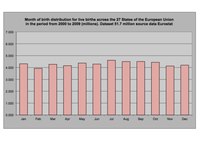
Photo from wikipedia
Abstract Objective To assess the effect of fetal gender in small-for-gestational age (SGA) neonates with birth weight less than the fifth percentile by gestational age. Methods We compared male and… Click to show full abstract
Abstract Objective To assess the effect of fetal gender in small-for-gestational age (SGA) neonates with birth weight less than the fifth percentile by gestational age. Methods We compared male and female SGA neonates for maternal and neonatal outcomes in the following gestational age subgroups: at <32 + 6, 33 + 0–36 + 6 and at ≥37 + 0 weeks of gestation. Results We examined 159, 154 and 2363 SGA neonates born at <32 + 6, 33 + 0 to 36 + 6 and ≥37 weeks of pregnancy, respectively, whose birth weight was below the fifth percentile for gestational age and who met our inclusion criteria. Overall, there were no significant differences between the mothers of males and females, except that there were more males at term and the incidence of nulliparas was greater among the mothers of males. In terms of outcomes, males had a similar incidence of respiratory distress syndrome (RDS), intraventricular hemorrhage (IVH) and admissions to intensive care. Interestingly, low Apgar scores were more common in preterm females born at 33–37 weeks and vice versa in births over 37 weeks. Conclusion Our data do not support an advantage of either gender in preterm birth of infants who are most likely growth restricted.
Journal Title: Journal of Perinatal Medicine
Year Published: 2019
Link to full text (if available)
Share on Social Media: Sign Up to like & get
recommendations!